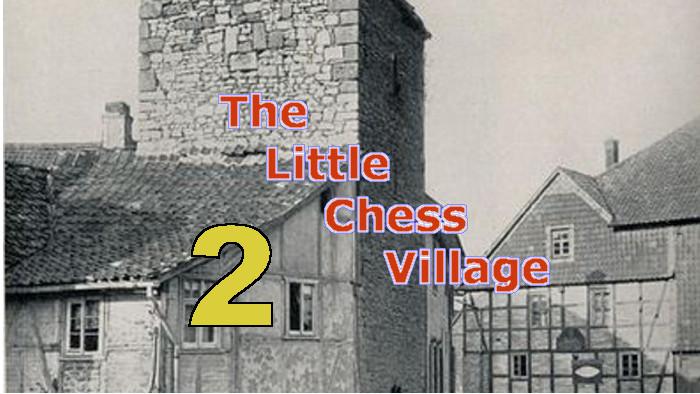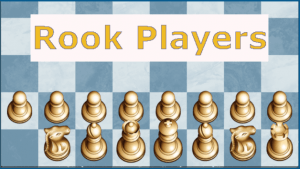
The Little Chess Village, Part II

n  1616 Augustus of Brunswick‑Lüneburg, writing as Gustavus Selenus in his work, "Das Schach- oder König-Spiel," tells of his visit to Ströbeck where he encountered three types of chess being played. One was the Mediæval Chess, which had been the staple of Europe for centuries, second was the Courier Game, played on a 12 by 8 square board while following Mediæval rules with some modifications and third, what he called the Welsch Game which resembled Modern Chess with some very peculiar differences and which is sometimes called the Ströbeck Game.
1616 Augustus of Brunswick‑Lüneburg, writing as Gustavus Selenus in his work, "Das Schach- oder König-Spiel," tells of his visit to Ströbeck where he encountered three types of chess being played. One was the Mediæval Chess, which had been the staple of Europe for centuries, second was the Courier Game, played on a 12 by 8 square board while following Mediæval rules with some modifications and third, what he called the Welsch Game which resembled Modern Chess with some very peculiar differences and which is sometimes called the Ströbeck Game.
 1616 Augustus of Brunswick‑Lüneburg, writing as Gustavus Selenus in his work, "Das Schach- oder König-Spiel," tells of his visit to Ströbeck where he encountered three types of chess being played. One was the Mediæval Chess, which had been the staple of Europe for centuries, second was the Courier Game, played on a 12 by 8 square board while following Mediæval rules with some modifications and third, what he called the Welsch Game which resembled Modern Chess with some very peculiar differences and which is sometimes called the Ströbeck Game.
1616 Augustus of Brunswick‑Lüneburg, writing as Gustavus Selenus in his work, "Das Schach- oder König-Spiel," tells of his visit to Ströbeck where he encountered three types of chess being played. One was the Mediæval Chess, which had been the staple of Europe for centuries, second was the Courier Game, played on a 12 by 8 square board while following Mediæval rules with some modifications and third, what he called the Welsch Game which resembled Modern Chess with some very peculiar differences and which is sometimes called the Ströbeck Game.

Selenus' illustrations include the board and some of the pieces. Notice that the bottom right square is black; that's a feature of the Courier Game and sometimes of the Ströbeck Game :



This etching by Jan de Braij depicts Courier Chess in Holland mid 1600s

The following painting by Lucas von Leyden from 1520 shows the Courier Game more clearly.

Murray believed there were only two other attempts during the Middle Ages to enlarge the chessboard, both of which were noted in the Spanish MS. Alf. (Alfonso X's "Book of Games") - one on a 10 by 10 square board and the other on a 12 by 12 square board. Murray further believes they were of Muslim origin and the manuscript didn't take them seriously.

12 x12 board from Alfonso X
The Courier Game was found in Germany as well as in Holland, but faded out in all these places except for in the village of Ströbeck where it was still played into the early 19th century.
The Courier set consisted of 12 pawns, 2 Rooks, 2 Bishops, 2 Knights, 2 Couriers, 1 Man or Counsellor, 1 Schleich or Jester, 1 King and 1 Queen. The game is played from an initial set-up that includes prescribed moves. Below is Murray's depiction of this starting position, something also shared by the Ströbeck Game. :




We've looked at Selenus' 1616 mention of chess in the village of Ströbeck, but there is a 2 century stretch of silence until we hear of this quaint chess village again. Suddenly three accounts of Ströbeck were published between 1821 and 1832. The first two were by Geman chess players H. C. Albers in 1821 and von Hirsch Silberschmidt in 1826. The third was given by the English player, William Lewis, in 1832. Albers account only considered the Courier Game (Courierspiele), offering some improvements and was rather short. Von Hirsch Silberschmidt and William Lewis not only mention the Ströbeck Game but each give 3 games they played against the Ströbeckians.
In 1825, von Hirsch Silberschmidt traveled to Ströbeck. He published his account - "die Reise nach Ströbeck" - in his book, "Die neu entdeckten Geheimnisse im Gebiete des Schachspiels" (pp. 177-193). He made the curious observation that the only chess manuals in the village were a very old copy of Gustatvus Selenus' "Schach- oder König-Spiel" and Johann Friedrich Wilhelm Koch's "Codex der Schachspielkunst." The villagers told Silberschmidt they were "natural" players who didn't study theory. Silberschmidt played 3 games against Ströbeckians - his opponents always chose to move second (although in the first game, Silberschmidt moved first with Black pieces)- winning all three rather easily.
Below are Silberschmidt's last two games.



This etching by Jan de Braij depicts Courier Chess in Holland mid 1600s
Curiously, a pen drawing of the same scene by Jan de Braij (Jan de Braÿ) was part of the "Album amicorum of Jacobus Heyblocq" in July 28, 1661. On the page of the album preceeding the drawning, the artist wrote: "You cannot play chess on your own, so if no one wants to play me then I shall have to abandon the game."

The following painting by Lucas von Leyden from 1520 shows the Courier Game more clearly.


12 x12 board from Alfonso X
The Courier Game was found in Germany as well as in Holland, but faded out in all these places except for in the village of Ströbeck where it was still played into the early 19th century.
The Courier set consisted of 12 pawns, 2 Rooks, 2 Bishops, 2 Knights, 2 Couriers, 1 Man or Counsellor, 1 Schleich or Jester, 1 King and 1 Queen. The game is played from an initial set-up that includes prescribed moves. Below is Murray's depiction of this starting position, something also shared by the Ströbeck Game. :

First row: Rook, Knight, Bishop, Courier, Sage, Queen, King, Jester, Courier, Bishop, Knight, Rook.
all the opponent's pieces face their corresponding pieces.
Murray submitted that the Courier Game had strong Asiatic characteristics that were introduced in the mid-13th century via the Mongol invasion. One of these features is the tabiya or the set-up from which a game is commenced. The above board shows the positon from which the Courier Game in Ströbeck began. The board was always placed with a dark square in the right corner.
all the opponent's pieces face their corresponding pieces.
Murray submitted that the Courier Game had strong Asiatic characteristics that were introduced in the mid-13th century via the Mongol invasion. One of these features is the tabiya or the set-up from which a game is commenced. The above board shows the positon from which the Courier Game in Ströbeck began. The board was always placed with a dark square in the right corner.
The moves and many rules of the pieces were Mediæval. There is no Castling. The pawn may only move one square forward, even on it's first move.
The Rook, the Knight and the King all move as in modern chess.
The Queen moves to any adjacent diagonal square.
The Sage moves the same a the King but couldn't be checked (or therefore limited to square not under attack).
The Jester moves one square horizontally or vertically.
The Courier moves exactly like the modern Bishop.
The Bishop, however, moves 2 squares digagonally, leaping over any adjacent occupied square.
The pawn retains for itself the most peculiar move of all. Upon reaching the 8th rank, the pawn has to perform what is called Freudensprünge. While on the 8th rank, the pawn is immune from capture, but can't be promoted until it has made 3 Freudensprünge or "joy leaps." These were 2-square jumps backward on the same file - a move the pawn can make only if both those squares are empty. After the first jump from 8 to 6, the second from 6 to 4 and the third from 4 to 2 - to the pawn's origninal square- the pawn promotes to a Queen only (and the Mediæval Queen is a very limited piece).
The Rook, the Knight and the King all move as in modern chess.
The Queen moves to any adjacent diagonal square.
The Sage moves the same a the King but couldn't be checked (or therefore limited to square not under attack).
The Jester moves one square horizontally or vertically.
The Courier moves exactly like the modern Bishop.
The Bishop, however, moves 2 squares digagonally, leaping over any adjacent occupied square.
The pawn retains for itself the most peculiar move of all. Upon reaching the 8th rank, the pawn has to perform what is called Freudensprünge. While on the 8th rank, the pawn is immune from capture, but can't be promoted until it has made 3 Freudensprünge or "joy leaps." These were 2-square jumps backward on the same file - a move the pawn can make only if both those squares are empty. After the first jump from 8 to 6, the second from 6 to 4 and the third from 4 to 2 - to the pawn's origninal square- the pawn promotes to a Queen only (and the Mediæval Queen is a very limited piece).
It may be worthwhile to note that the Ströbeck tabiya and the pawn Freudensprüng were also features of the Ströbeck Game (modern chess as played in Ströbeck).
Most historians believe that the Courier Game was first mentioned in Wirnt of Grafenberg's epic early 13th century Arthurian poem "Wigalois" because of the following lines that mention the games of "Backgammon and Courier," as well as pieces of gems and ivory rather than wood.:
lagen vor der frouwon fler
Wurfzabel unde kurrier,
Geworht von helfenbeine;
Mit edelem gesteine
Spilten si, mit holze niht,
Als man nu frouwen spilen siht.
Two early 14th century works, Das Schachzabelbuch des Konrad von Ammenhausen and Das Schachgedicht Heinrichs von Beringen, both moralities in verse based upon Cessolis' "Ludum Scaccorum," gave mention of the Courier Game. So we know for certain, if not in 1200 AD, the game at least existed in Europe in 1300 AD. When it arrived in Ströbeck is less certain.
lagen vor der frouwon fler
Wurfzabel unde kurrier,
Geworht von helfenbeine;
Mit edelem gesteine
Spilten si, mit holze niht,
Als man nu frouwen spilen siht.
Two early 14th century works, Das Schachzabelbuch des Konrad von Ammenhausen and Das Schachgedicht Heinrichs von Beringen, both moralities in verse based upon Cessolis' "Ludum Scaccorum," gave mention of the Courier Game. So we know for certain, if not in 1200 AD, the game at least existed in Europe in 1300 AD. When it arrived in Ströbeck is less certain.



We've looked at Selenus' 1616 mention of chess in the village of Ströbeck, but there is a 2 century stretch of silence until we hear of this quaint chess village again. Suddenly three accounts of Ströbeck were published between 1821 and 1832. The first two were by Geman chess players H. C. Albers in 1821 and von Hirsch Silberschmidt in 1826. The third was given by the English player, William Lewis, in 1832. Albers account only considered the Courier Game (Courierspiele), offering some improvements and was rather short. Von Hirsch Silberschmidt and William Lewis not only mention the Ströbeck Game but each give 3 games they played against the Ströbeckians.
William Lewis described the rules of the Ströbeck Game in his chapter, "Journey to Ströbeck" :
The Game at Chess as now played at Stroebeck, differs from that commonly played in the following particulars:
—The pieces being placed as usual, each party is obliged to play his king's rook's pawn, queen's rook's pawn, and queen's pawn two squares, and the queen to her third square.
—No other pawn can be moved two squares at a time.
—The king is not allowed to castle. (I was informed by one of the inhabitants that some of the players have lately allowed castling.)
—When a pawn has reached the last line, it does not at once assume the powers of a queen or any other piece, but it must first make three joyous leaps (Freudensprung) of two squares at a time, until it reach the square on which it was at first placed.
—The pieces being placed as usual, each party is obliged to play his king's rook's pawn, queen's rook's pawn, and queen's pawn two squares, and the queen to her third square.
—No other pawn can be moved two squares at a time.
—The king is not allowed to castle. (I was informed by one of the inhabitants that some of the players have lately allowed castling.)
—When a pawn has reached the last line, it does not at once assume the powers of a queen or any other piece, but it must first make three joyous leaps (Freudensprung) of two squares at a time, until it reach the square on which it was at first placed.
In 1825, von Hirsch Silberschmidt traveled to Ströbeck. He published his account - "die Reise nach Ströbeck" - in his book, "Die neu entdeckten Geheimnisse im Gebiete des Schachspiels" (pp. 177-193). He made the curious observation that the only chess manuals in the village were a very old copy of Gustatvus Selenus' "Schach- oder König-Spiel" and Johann Friedrich Wilhelm Koch's "Codex der Schachspielkunst." The villagers told Silberschmidt they were "natural" players who didn't study theory. Silberschmidt played 3 games against Ströbeckians - his opponents always chose to move second (although in the first game, Silberschmidt moved first with Black pieces)- winning all three rather easily.
Below are Silberschmidt's last two games.
William Lewis visited Ströbeck during his trip to Gemany in the summer of 1831. As noted above, he explained some of the rules of chess as the people of Ströbeck played it. It seems that at one time the black square was in the bottom right of the board, then later the white square. Below are two games played between Lewis and the Ströbeckians. The first on is rather complex to present since in employs moves that viewers can't handle. The second game is rather straight forward. It's good to remember that both Silberschmidt and Lewis were new to the type of chess played in Ströbeck and had to work out the strategy on the fly.
Game 1:
Lewis' first game is of particular interest (and viewer unfriendly) since involved the Freudensprung moves.
White's pawn reaches the 8th rank. ...Kc6 
The b pawn's first Freudensprung - to b6 ...Kb5 

e5 ...h2

d5 ...exd5

exd5 ...h8

d6 ...f5

d7 ...f4

d8 ...h4

Freudensprung -to d6 ...h3

Freudensprung -to d4 ...h2

Freudensprung and the b pawn Queens ...Ka4

Kc4 ...Ka3

Qe2 ...Ka4

Mate

Game 3:







